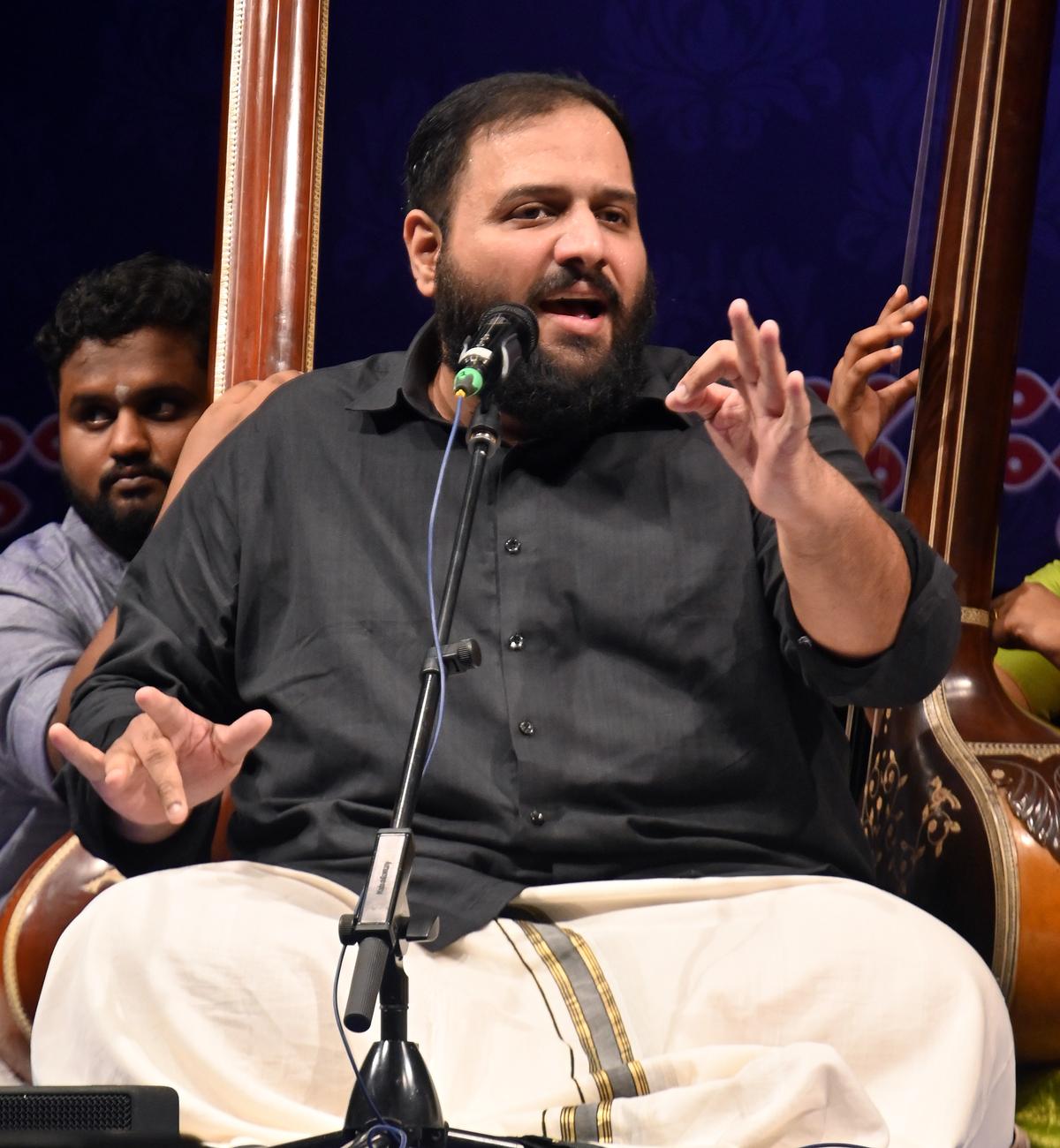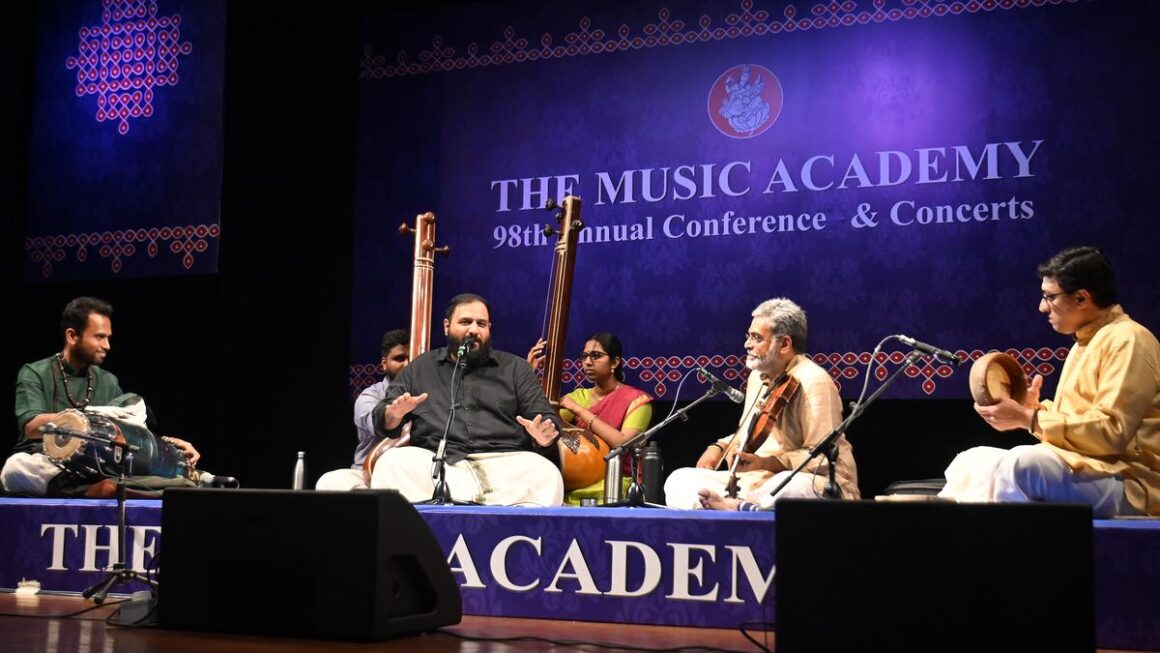
Vignesh Ishwar with H.K. Venkatram (violin), Praveen Sparsh (mridangam) and Guru Prasanna (kanjira).
| Photo Credit: K. Pichumani
Vignesh Ishwar is among the more promising young vocalists of the new era. His current training under T.M. Krishna has helped shape his talent, and also steered his presentation style towards his guru’s, as was evident at his concert for The Music Academy’s 2024 December festival. There were moments that seemed straight out of Krishna’s concert playbook.
Vignesh’s talent table is outstanding, with his booming voice capping it. He has a good mix of tempos and largely the famed repertoire of old stalwarts. ‘Munnu ravana’ (Todi, Tyagaraja, Misra Jhampa), ‘Sankachakra’ (Poorna Chandrika, Dikshitar), ‘Epamu’ (Atana, Tyagaraja, Misra Chapu) and the rapid ‘Ninnu joochi’ (Sowrashtram, Patnam Subramania Iyer) are shining examples.
‘Munnu ravana’ in a brisker velocity with many accented syllables delivered via a strong voice was a cracker of a start. Vignesh’s rapid raft lifted the concert expectations instantly. It’s a moot point whether you amplify a canon voice further, as Vignesh chose to, or let the sound system tame it a bit to reach the ears at the optimum frequency. Vignesh followed the opening piece with ‘Sankachakra’ in Poorna Chandrika, with characteristic swaras in attractive ascends and descends, emphasising the rishabam and ‘p d p’ phrases. A softly rendered Hamir Kalyani raga showcased the serene half of Vignesh’s skillsets. Good rendition of ‘Venkata sailavihara’ by Subbaraya Sastry, which has a Dikshitaresque gait, evened out the opening frenzy.
Manodharma was well-distributed in the first three songs — niraval in ‘Munnu ravana’, swara in ‘Sankachakra’ and raga alapana in the Hamir Kalyani piece — this intelligence eludes many musicians as one hears a truckload of swaras early on in concerts, colliding with sensitivities.H.K. Venkatram’s exquisite accompaniment for ‘Venkatasaila vihara’ deserves special mention, as his alapana was authentic and crisp.
Vignesh’s Atana alapana was bright and generally on predictable lines. The sancharas in the top notes were attractive. ‘Epamu’ in Misra Chapu is among the few seminal kritis in this raga for elaboration. The first line of the pallavi is loaded with such a vast milieu of sangathis that the raga seems complete with it in itself. Vignesh’s further delineation of the kriti and especially the niraval at ‘Rajasekara’ seemed superfluous, as repetitions are difficult to avoid in such ragas. This is where he came close to be the carbon copy of the guru’s typical rendition.
Parveen Sparsh’s mridangam was organised and supportive with occasional pep when demanded. His playing for the slower ‘Venkatasaila vihara’ was noteworthy dovetailing well with the mood. Tani with Guru Prasanna was well-manicured exploiting the Misra Chapu contours.

Vignesh Ishwar began the concert on a vibrant note with ‘Munnu ravana’
| Photo Credit:
K. Pichumani
Even as the Atana kriti took longer than ideal, Vignesh still found generous time for his Ragam Tanam Pallavi in Ritigowla. His raga alapana and that of Venkatram were soothing and succinct. The tanam presented some challenges to Vignesh as, perhaps, a structure was not particularly evident.
The Khanda Triputa pallavi ‘Anbe kadavul’ in Tisra Triputa with an earlier start was competently rendered, both in the niraval and trikala phases. The pallavi is attributed, predictably, to his guru Krishna. Ragamalika swara in Nattakurinji, Mukhari, Desh and Surutti enhanced the audience appeal.
Vignesh’s appetite for raga alapanas was showcased further in the virutham in Sahana and Sindhu Bhairavi , followed by the Tamil composition, ‘Nadantha kaalgal’ in an interesting nadai. This was a concert that offered strong manodharma and refined creativity, while unmistakably underlining the tutelage. How Vignesh coalesces the voice trump card with aesthetic virtues would determine his further progression.
Published – December 30, 2024 12:46 am IST


Leave a Reply